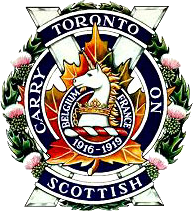For centuries, fighting men have marched into battle to the accompaniment of stirring music, whether it be fife and drum or military band, but perhaps the most stirring music of all is that of the pipes and drums. The sound of the pipes and the beat of the drums is a sound that has led men into battle for centuries and is guaranteed to send a chill up your spine.
One of the most famous Scottish Regiments in Canada today is The Toronto Scottish, a regiment that perpetuates the fighting 75th Battalion from WWI. Lieutenant-Colonel S.G. Beckett recruited the 75th Bn in 1915 and became its first Commanding Officer. The 75th served in France from August 1916 until the armistice in 1918 and it was committed to every major engagement in which the Canadian Corps took part. A great loss occurred during a raid on Vimy Ridge in March 1917, when Lieutenant-Colonel Beckett was killed attempting to rally his men, following a costly assault upon the enemy trenches. The 75th faced very difficult assignments throughout the war over one thousand officers and men were killed by war's end. For acts of gallantry, 242 members of the battalion received decorations including the award of the Victoria Cross to the battalion Medical Officer, Captain B.S. Hutcheson, already a recipient of the Military Cross. The battalion was awarded 16 Battle Honours for WWI of which 10 are emblazoned on the Regimental Colour, including Somme, Vimy Ridge, Passchendaele and Amiens.
Following the war, the 75th Bn became The Mississauga Regiment in the post-war Canadian Militia and then in the early 1920s, on the insistence of Lieutenant-Colonel C.C. Harbottle, became The Toronto Scottish Regiment. Shortly afterwards, Lieutenant-Colonel Harbottle received permission to establish an affiliation with The London Scottish and through The London Scottish to The Gordon Highlanders. By consent of The London Scottish, The Toronto Scottish adopted its dress which, with minor adaptations of historical significance, it continues to wear. The fabric in which the kilt and full dress jacket are made is known as 'Hodden Grey', a tartan well known to the Scottish peasantry. The tartan was chosen by Lieutenant-Colonel Lord Elcho of the London Scottish Regiment in 1859. He sought to avoid all interclan feeling on the subject of tartan, and as soldiers, wanted his troops to blend in with the landscape of the battlefield.
With the outbreak of war in 1939, The Toronto Scottish mobilized as a machine-gun unit and almost to a man every peace-time soldier volunteered for active service. The Toronto Scottish embarked for England on December 7 and arrived at Gourock, Scotland 10 days later. The Scottish were the first complete Canadian unit to land in the United Kingdom following the declaration of war and had the great honour of mounting the King's Guard at Buckingham Palace. In April 1940, led by the Pipes and Drums. The Queen was reported to have said, "we can sleep well tonight-the Canadians are on guard." The Queen became the Colonel-in-Chief of The Toronto Scottish in 1938.
The Toronto Scottish was the only Canadian unit to be on French soil at three different times during the war-Brest, 1940; the bloody debacle at Dieppe, 1942 and Normandy, at D-Day plus 30, for the duration of the war. Twenty-one battle honours were awarded to the regiment for WWII of which 10 appear on the Regimental Colours, including: Dieppe, Falaise, St. Andre-sur-Orne and The Scheldt.
Following the war, The Toronto Scottish was redesignated an infantry unit again. Through National survival training in the 1950s, unification in the 1960s, civil defense in the 1970s up to present day, all the while sending trained soldiers to augment regular force units on UN Peacekeeping, The Toronto Scottish has been, and is still, a very integral part of the Canadian Forces Primary Reserve. Today the Regiment is part of 32 Canadian Brigade Group as soldiers and musicians.
The Toronto Scottish Regiment received the honour of the addition of the title “Queen Elizabeth The Queen Mother’s Own” from Queen Elizabeth II, on the occasion of the Queen Mother’s 100th birthday in 2000. The Queen Mother passed away in 2002, having served the Regiment for 65 years as the Colonel-in-Chief. Her Majesty, The Queen Mother Elizabeth, was the longest serving Royal Colonel-in-Chief in Canadian history.
After the passing of Her Majesty Queen Elizabeth, The Queen Mother, the title of Colonel-in-Chief was passed to His Royal Highness, Charles, The Prince of Wales.

